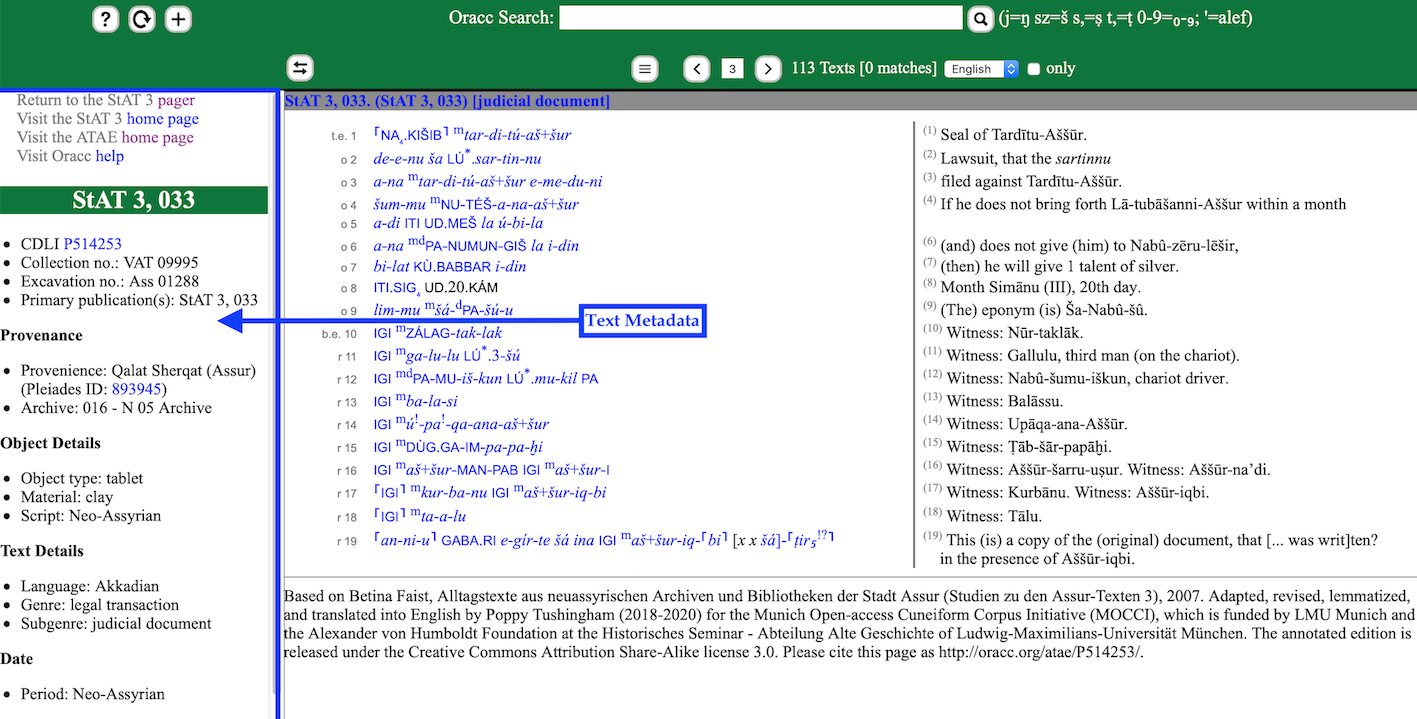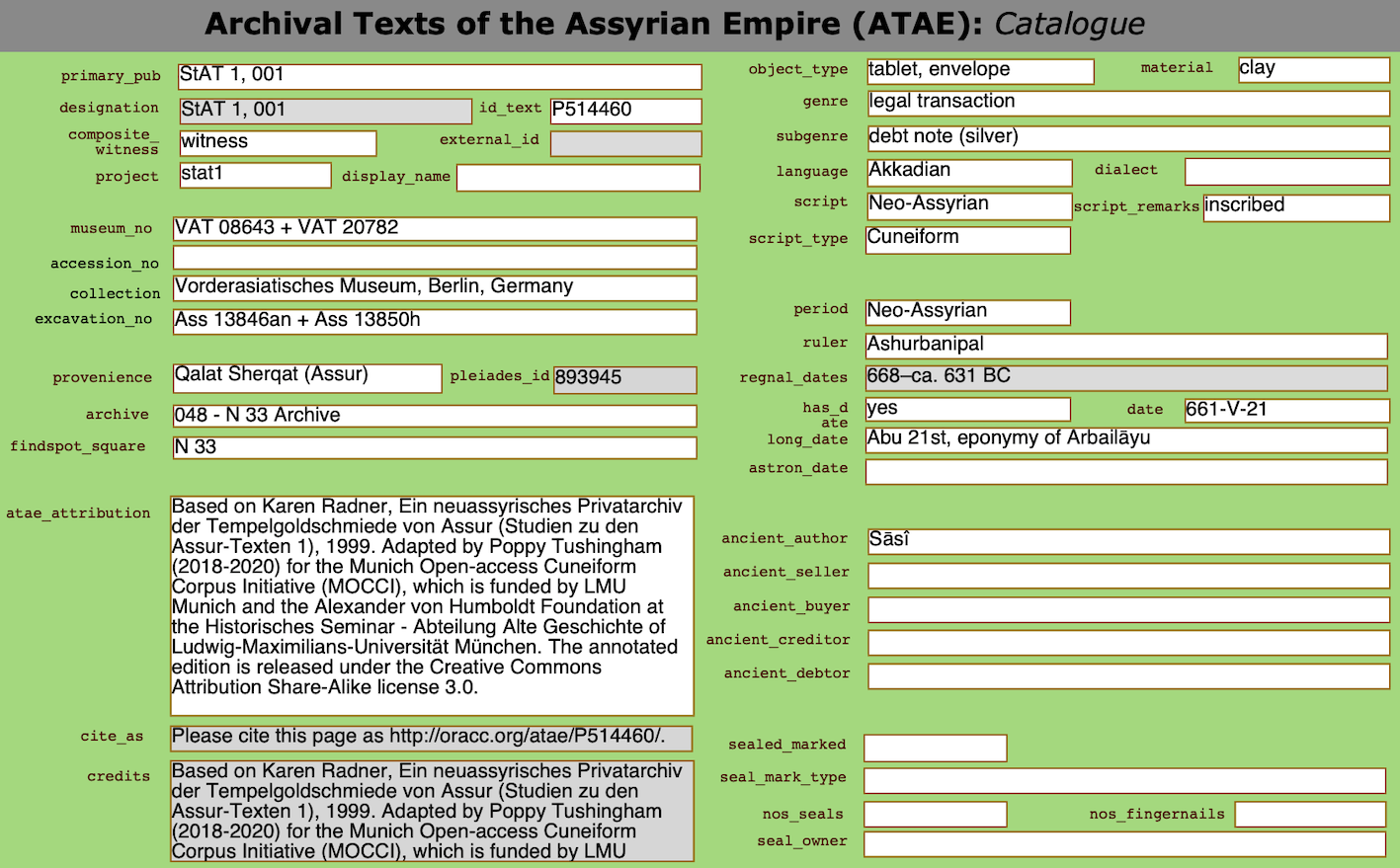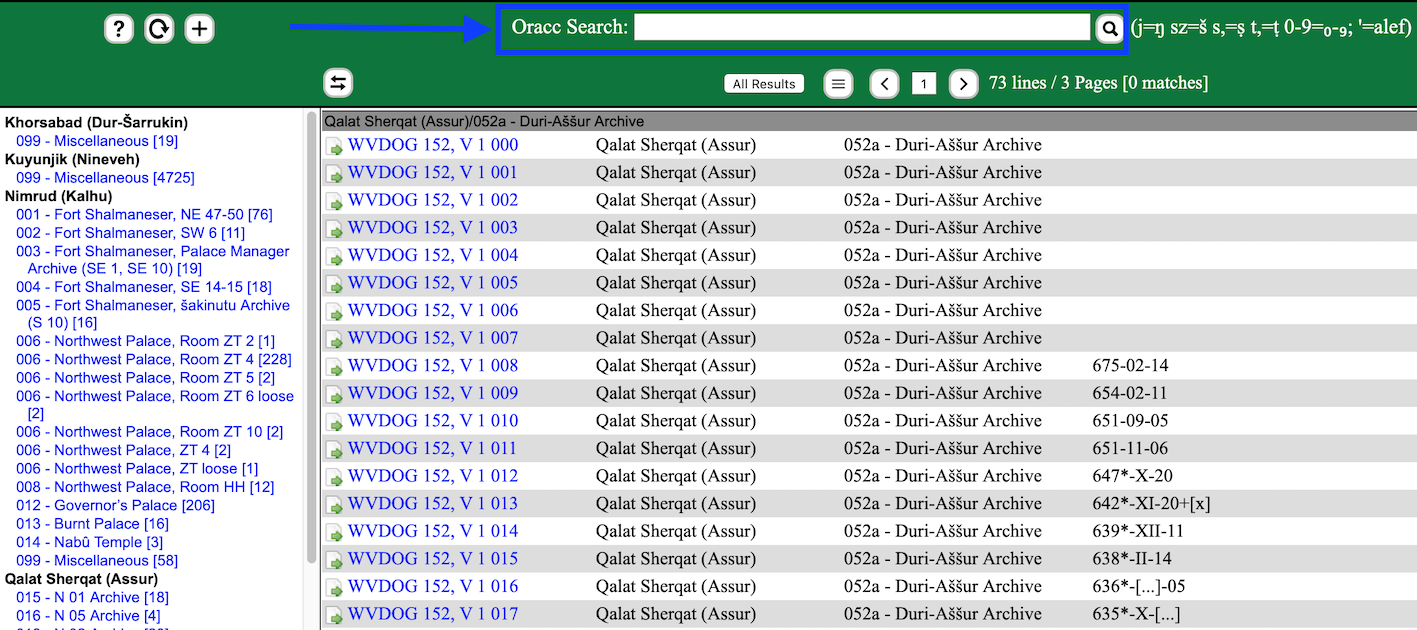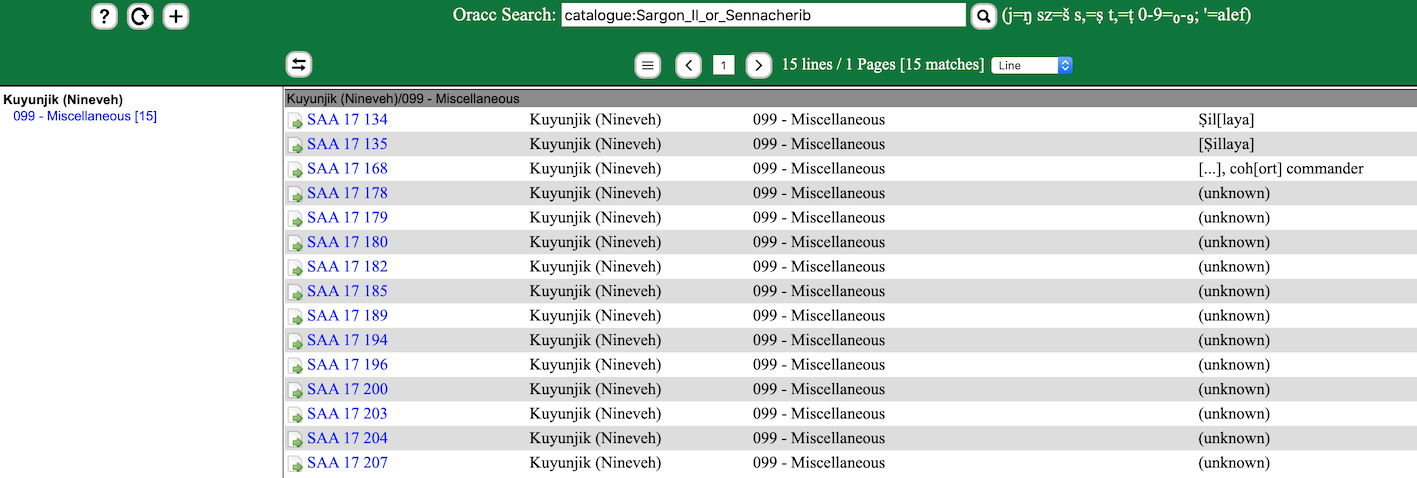Metadata View
To make ATAE and its numerous subproject a little more user friendly, we have customized the metadata frame of the Item View (see the image below) so that more information about the texts included in this subproject are accessible to ATAE users. This page will give a brief overview of the information now provided in the metadata frame of the Item View.

General Information Links
This section contains four links:
- a link to return to the corpus pager [/atae/pager];
- a link to the (sub-)project home page [/atae/];
- a link to main ATAE home page [/atae/]; and
- a link to the Oracc help pages [http://oracc.museum.upenn.edu/doc/help/index.html].
Designation
The text designation is displayed in the dark green background. This is generally the publication abbreviation (here, "StAT 3" for "Studien zu den Assur-Texten 3") and the text number within that publication (with leading zeros).
Numbers
The numbers section displays the following information (when known):
- a hyperlinked CDLI number ("P" plus six digits), which loads the CDLI record for the object;
- the object's collection and accession number;
- the object's excavation number; and
- the text's primary publication(s) (usually the CTN or StAT number).
The collection, accession, and excavation numbers follow CDLI formatting. For example, K 982 (=SAA 17 010) displays as K 00982 (with two leading zeros). Leading zeros are also used for the primary publications. Thus, ABL 0833 for ABL 833.
Provenance
The provenance section contains general information about the find spot of the text, if known. The metadata included here is:
- Provenance, with a link to the place resource on Pleiades [https://pleiades.stoa.org], a community-built gazetteer and graph of ancient places; and
- the archival context of the text, if known;
The Archive information is generally based on Pedersén, Archives and Libraries in the Ancient Near East 1500-300 B.C., with a few additions and sub-divisions.
Object Details
The object details section contains information about the object and material support upon which the text is inscribed. Ninety-nine percent of the texts included here are written on clay tablets. The other one percent generally comprises clay envelopes, bulla, and tags. Moreover, additional information about whether or not a tablet is impressed with (a) seal(s) or fingernail mark(s) is included here, including the name of the owner(s) of the seal(s). The metadata included in this section is:
- Object type (usually "tablet," but also "envelope," "bulla," "tag")
- Material (almost always "clay")
- Script (usually "Neo-Assyrian," but occasionally "Neo-Babylonian")
- Sealed/Marked (indicates whether the tablet/envelope is impressed with a seal of fingernail)
- Seal/Mark Type (usually "cylinder seal," "stamp seal," or "fingernail mark");
- Number of Sealings
- Number of Fingernail markings; and
- Seal Owner(s).
Text Details
The text details section contains general information about the text itself. The metadata included here is:
- language (dialect) (usually "Neo-Assyrian," but occasionally "Neo-Babylonian");
- genre (of the text);
- gubgenre (of the text);
- the name of the sender(s) (in letters;
- the (proposed) location of the sender(s) (in letters;
- the name/title of the recipient (in letters);
- name of the seller (in sales contracts);
- name of the buyer (in sales contracts);
- name of the creditor (in debt notes); and
- name of the debtor (in debt notes).
Date
The date section includes the following information, when known:
- period (generally "Neo-Assyrian," but sometimes "Middle Assyrian");
- ruler and regnal dates, for example, "Sargon II (721-705 BC)" or "Sennacherib (704-681 BC)";
- a notation on whether or not the object bears a date and whether or not the date formula is fully/partially persevered or completely destroyed; and
- the date given inscribed on the object or the date assumed/proposed by modern scholars.
The "Dated" metadata information has four options: (1) yes, when the object bears a complete date; (2) yes, but partially preserved, when the date is damaged; (3) yes, but completely destroyed, when it is (fairly) certain that the object originally was dated but now missing (due to the fragmentarily nature of the clay object); and (4) no, when the object was not dated at the time it was inscribed.
For yes and yes, but partially preserved,
the Metadata View will display the ancient date. 'Short' and 'long'
dates are (generally) given for these texts. The 'long' date records
the information as it appears on the object, while the 'short' date
converts the information into the format YEAR-MONTH-DAY. Months in the
'short' date are always given in upper case Roman numerals. For example,
the date of StAT 1, 001 [/atae/P514460] is
661-V-21 (Abu 21st, eponymy of
Arbailāyu). The Mesopotamian month names and their modern equivalents are:
| I | Nisannu | March–April | VII | Tašrītu | September–October |
|---|---|---|---|---|---|
| II | Ayyāru | April–May | VIII | Araḫsamna | October–November |
| III | Simānu | May–June | IX | Kislīmu | November–December |
| IV | Duʾūzu | June–July | X | Ṭebētu, Kanūnu | December–January |
| V | Abu | July–August | XI | Šabāṭu | January–February |
| VI | Ulūlu | August–September | XII | Addaru | February–March |
| VI₂ | Intercalary Ulūlu | XII₂ | Intercalary Addaru |
For yes, but completely
destroyed and no, the Metadata View might display a proposed date, if one has
been suggested (and included in the ATAE catalogue). All suggested
dates are placed between parentheses. For example, the proposed date
of CTN 1, 07 [/atae/P224682] is (791–778) is its date is completely destroyed, but can be conjected from dated "Wine Lists" from Kalhu (modern Nimrud).
Note that the information provided for the "reign" is based solely
on the information given for the "(proposed) date." For example, for
the texts edited in SAA 17 [saao/saa17], the
reign information will be Sargon II (721-705), Sennacherib (704-681), or Sargon II (721-705) or Sennacherib (704-681), since this is the suggested scholarly date of those pieces of royal correspondence.
Bibliography
When additional bibliography is included, those publications will be listed under the bibliography section.
Views
At present, one view of the text is possible: Print text, which allows users to print the transliteration and translation of the text.
The ATAE catalogue has forty-six searchable fields. These are: accession_no, ancient_author, ancient_buyer, ancient_creditor, ancient_debtor, ancient_seller, archive, astron_date, atae_attribution, cite_as, collection, composite_witness, credits, date, designation, dialect, display_name, excavation_no, external_id, findspot_square, fingernails_number, genre, has_date, id_text, language, last_mod_by, last_modified, long_date, material, museum_no, object_type, period, pleiades_id, primary_publication, project, provenience, regnal_dates, ruler, script, script_remarks, script_type, seal_mark_type, seal_owner, sealed_marked, seals_number, subgenre.

You can search any of these fields in the ATAE pagers by using the Oracc Search window.

You can search the entire database or a specific field. To search the entire catalogue, enter catalogue: into the Oracc Search bar and the search criteria. For example, catalogue:Khorsabad.

NOTE: If your search comprises more than one word, then use an underscore (_) instead of a blank space between the words. For example, catalogue:Sargon_II_or_Sennacherib.

If you want to only search one field, enter the field name (without the underscrores) plus : and then the search criteria. For example, ancientauthor:Nabu-bel-šumati; ancientauthor:Nabu-bel-szumati (with sz instead of š) and ancientauthor:Nabubelszumati (with sz instead of š and without hyphens) will also return results.

Jamie Novotny
Jamie Novotny, 'Metadata View', Archival Texts of the Assyrian Empire (ATAE), The ATAE Project, a sub-project of MOCCI, 2021 [http://oracc.org/atae/ataemetadataview/]